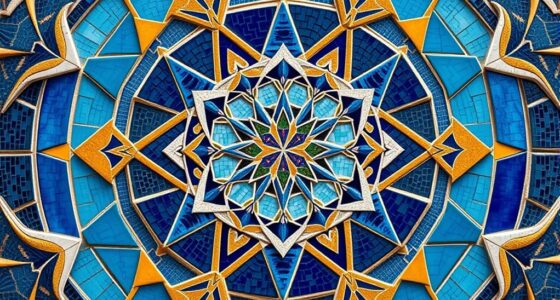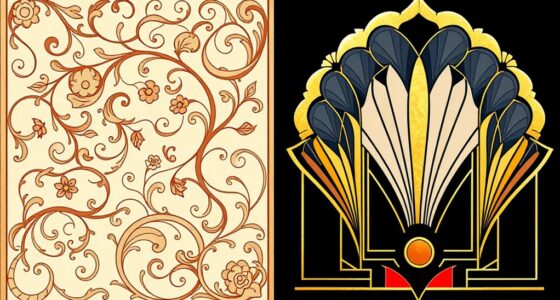The Silk Road’s pattern influence in carpets reflects centuries of cultural exchange, trade, and storytelling. You’ll notice traditional motifs like geometric shapes, floral designs, and symbolic symbols that vary by region, representing protection, spirituality, or fertility. These patterns are passed down through skilled craftsmanship, blending local and foreign styles. To discover how these intricate designs continue to inspire modern carpets and preserve cultural heritage, keep exploring the fascinating history behind them.
Key Takeaways
- Silk Road trade facilitated the exchange of textiles, motifs, and weaving techniques, influencing regional carpet patterns.
- Cultural symbols and motifs in carpets reflect centuries of cross-cultural interactions along trade routes.
- Colors and geometric designs encode spiritual, societal, and protective meanings from diverse regions.
- Regional variations in patterns reveal unique cultural identities shaped by trade and local traditions.
- Modern reinterpretations preserve Silk Road motifs, blending traditional symbolism with contemporary design aesthetics.
Historical Roots of Silk Road Design Elements

The design elements found in carpets along the Silk Road have deep roots that reflect centuries of cultural exchange. As trade route innovations expanded, they facilitated the movement of textiles, ideas, and artistic techniques across Asia, the Middle East, and Europe. These interactions introduced new motifs, color palettes, and weaving methods into local traditions, shaping the distinctive patterns seen today. You can see how cultural exchange influences are embedded in the intricate details, blending symbols from different regions into cohesive designs. These trade-driven exchanges didn’t just spread goods—they also transmitted artistic concepts, enriching local craftsmanship. Over time, these design elements became a visual record of cross-cultural interactions, making Silk Road carpets a testament to the enduring legacy of trade route innovations and cultural exchange influences.
Symbolism and Motifs in Traditional Carpet Patterns
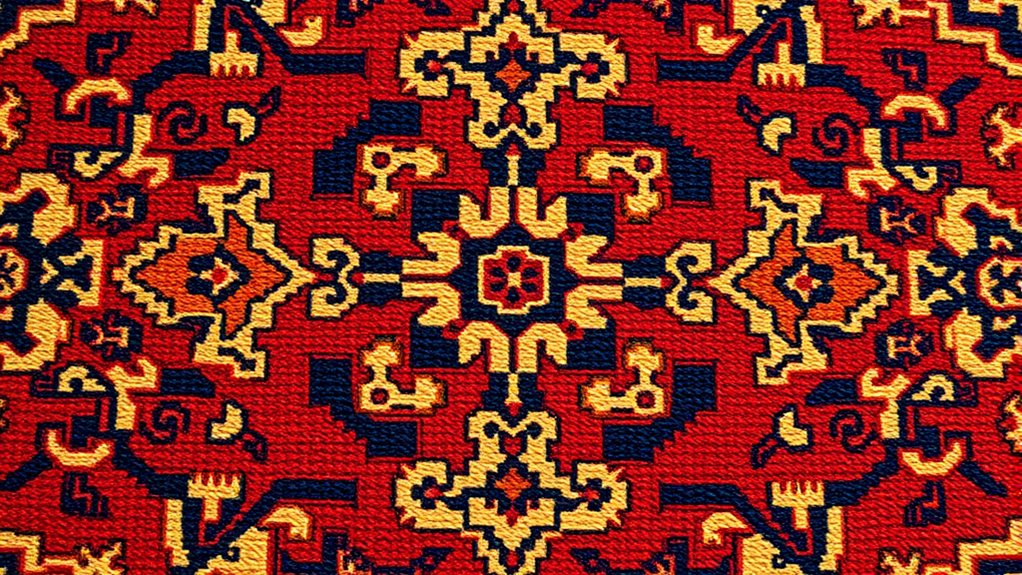
Traditional carpet patterns are rich with symbolism and meaningful motifs that convey cultural values, beliefs, and stories. You’ll notice how color symbolism influences design, with reds representing passion or protection, blues symbolizing spirituality, and greens signifying nature. Geometric motifs, such as diamonds, stars, and medallions, reflect spiritual beliefs and societal ideals. These shapes often encode protective symbols or fertility signs. Here’s a visual representation of common motifs:
| Shape | Meaning | Color Significance |
|---|---|---|
| Diamond | Protection, fertility | Red, white |
| Star | Spirituality, guidance | Blue, gold |
| Medallion | Unity, eternity | Various, depending on culture |
| Cross | Balance, harmony | Black, white |
| Tree of Life | Connection, growth | Green, brown |
You interpret these motifs as a language, telling stories through pattern and hue. Additionally, these motifs often serve as cultural identifiers that connect artisans to their heritage and history.
Regional Variations and Cultural Significance
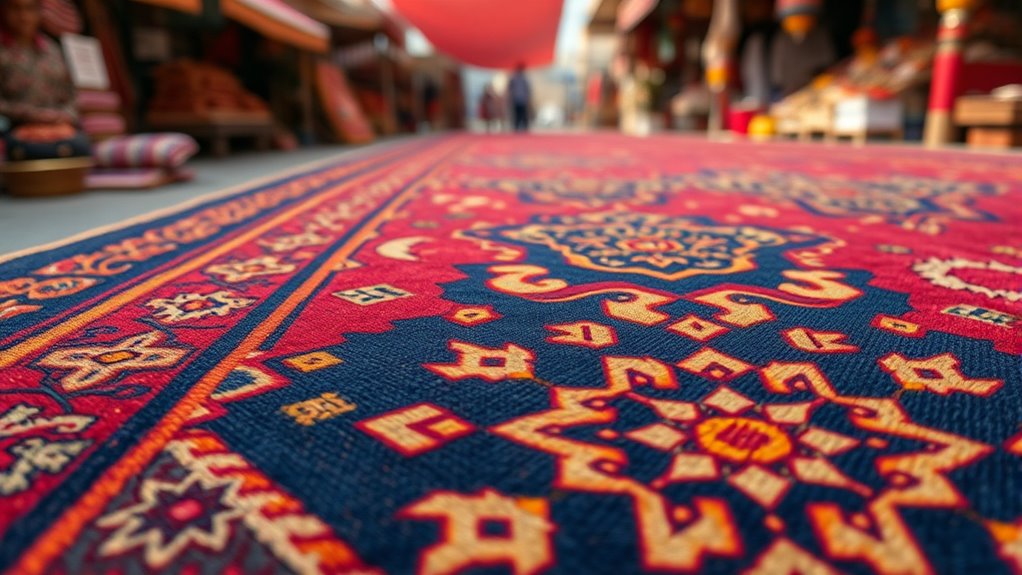
Regional variations in carpet patterns reveal distinct cultural identities and historical influences that shape local weaving traditions. You’ll notice how each region’s craftsmanship reflects its unique history, values, and stories. These variations serve as cultural storytelling, conveying legends, beliefs, and social status through intricate designs. For example, Persian carpets often feature floral motifs symbolizing paradise, while Central Asian rugs highlight geometric patterns representing protection. By examining these differences, you gain insight into the community’s worldview and cultural priorities. These regional distinctions aren’t just aesthetic; they embody a sense of identity passed down through generations. As you explore these carpets, you see how craftsmanship and tradition intertwine, making each piece a vibrant expression of its cultural roots and a memorial to regional storytelling. Additionally, understanding the woven techniques used in different areas can deepen appreciation for the skill and heritage embedded in each carpet.
Techniques and Materials Passed Along Trade Routes
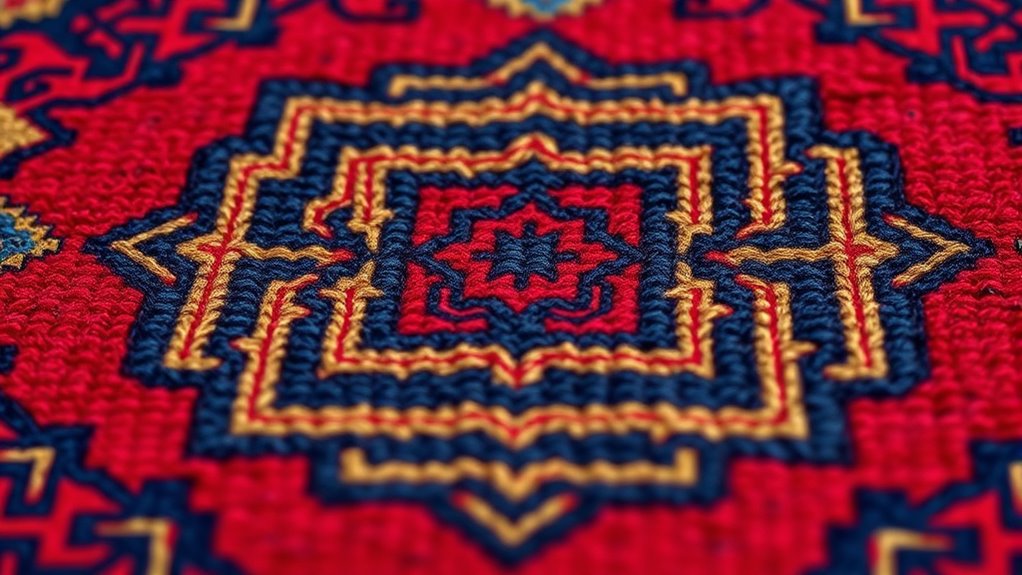
Trade routes have spread dyed wool and silk across regions, influencing local carpet styles. You’ll notice how knotting and weaving techniques evolve as artisans adapt these materials. Exploring these methods reveals how cultural exchanges shape the patterns we see today. Additionally, the incorporation of vintage decor elements and traditional motifs demonstrates how historical influences persist in contemporary designs.
Dyed Wool and Silk
The techniques for dyeing wool and silk in carpet making have traveled along ancient trade routes, transforming local materials into vibrant, lasting colors. You’ll find that natural dyes, derived from plants, minerals, and insects, played a key role in this process. These dyes not only produced rich hues but also contributed to textile preservation, helping carpets withstand the test of time. As you examine carpets from different regions, you’ll notice the subtle variations in color intensity, reflecting the local dyeing traditions and available resources. The mastery of dyeing with natural substances allowed artisans to create intricate patterns with depth and vibrancy, reinforcing the cultural exchanges along trade routes. Additionally, the use of multi-functional materials in dyeing techniques enabled more complex and durable designs. This blend of technique and material highlights the enduring influence of the Silk Road on carpet artistry.
Knotting and Weaving Styles
Have you ever wondered how different knotting and weaving styles shape the unique character of carpets? These techniques reflect tapestry craftsmanship passed along trade routes, blending regional influences and cultural artistry. Knotting styles, such as Persian knots or Turkish knots, create distinct pile textures and durability, giving each carpet its signature look. Weaving methods vary from dense, high-pile techniques to flatweaves, influencing both appearance and function. Dyeing techniques also play a vital role, affecting color richness and pattern clarity. As materials traveled along the Silk Road, artisans adapted their methods, integrating new fibers and dyes. The craftsmanship of knotting and weaving, combined with innovative dyeing, results in carpets that are not only beautiful but also rich with cultural history, showcasing the diverse influences passed through centuries of trade. Additionally, fiber selection techniques evolved as different regions gained access to new materials, further enriching the diversity of carpet styles and qualities.
Modern Interpretations of Silk Road-Inspired Patterns

Modern interpretations of Silk Road-inspired patterns breathe new life into ancient motifs, blending historical symbolism with contemporary aesthetics. You’ll notice how designers incorporate contemporary motifs, such as geometric shapes and stylized symbols, into traditional patterns. These abstract reinterpretations often simplify complex designs, making them more versatile for modern decor. Instead of replicating historical details precisely, artisans experiment with scale, color, and form, creating fresh takes on classic motifs. This approach allows you to enjoy the rich symbolism of Silk Road patterns while matching current interior trends. As a result, these carpets become statement pieces that honor history but also reflect your personal style. By embracing innovation, modern carpets showcase how ancient inspirations can evolve into striking, contemporary art forms. Discover a free tool to transform text capitalization styles to enhance your presentation of these designs.
Preserving Heritage: The Role of Artisan Craftsmanship
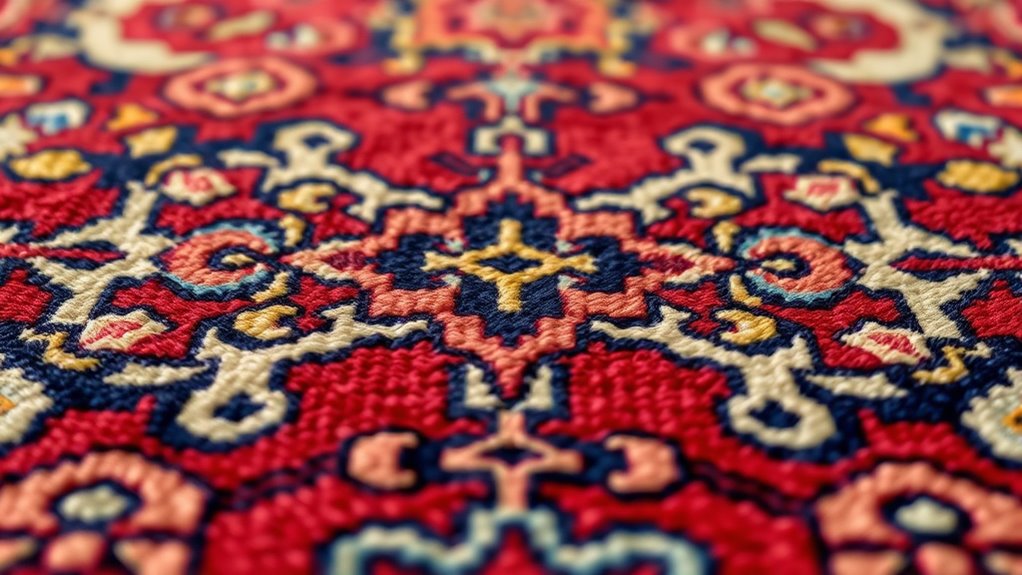
Artisan craftsmanship plays a crucial role in preserving the rich cultural heritage embedded in traditional carpet-making. When you engage in these skilled techniques, you help sustain centuries-old practices that define regional identities. Preserving this cultural heritage depends on artisans passing down their knowledge of intricate artisan techniques, ensuring authenticity endures. By valuing handcrafted carpets, you support the continuation of unique patterns and motifs that reflect cultural stories and histories. Your appreciation encourages artisans to maintain traditional methods, safeguarding these skills from fading into obsolescence. Recognizing the importance of cultural preservation helps motivate continued dedication to these timeless craft traditions. Ultimately, your recognition of craftsmanship helps keep alive the legacy of the Silk Road’s influence, ensuring that the artistry behind these carpets remains an essential part of cultural preservation for future generations.
Frequently Asked Questions
How Have Silk Road Patterns Influenced Contemporary Global Interior Design?
You see Silk Road patterns in contemporary interior design through cultural symbolism and artistic reinterpretation. These intricate motifs evoke a sense of history and exotic elegance, making spaces feel rich and meaningful. Designers blend traditional patterns with modern elements, creating a unique fusion that celebrates cultural heritage while appealing to current tastes. This influence adds depth and character, reminding us of a vibrant exchange of artistry and symbolism across centuries.
Are Silk Road-Inspired Carpets More Valuable Than Other Traditional Rugs?
Think of silk road-inspired carpets as treasures from a historic map—more valuable than other traditional rugs. Their cultural significance adds depth, making them sought after by collectors and enthusiasts alike. Market valuation often reflects this rarity and rich history, elevating their worth beyond typical rugs. If you’re after a piece with a story and prestige, silk road-inspired carpets stand out, turning your space into a gallery of cultural heritage.
What Are the Challenges in Authenticating Silk Road Heritage Carpets Today?
You face challenges in authenticating Silk Road heritage carpets because forgery detection is complex, and many forgeries mimic genuine patterns. Provenance verification, essential for confirming origin and age, often involves detailed historical research and expert analysis. You need to rely on advanced techniques like fiber analysis and provenance records, but limited documentation and skill gaps make it difficult to distinguish authentic pieces from modern reproductions.
Do Modern Artisans Face Difficulties Accessing Traditional Materials for These Patterns?
You might find that around 60% of artisans struggle with traditional materials, making it hard to replicate authentic Silk Road patterns. Modern sourcing often relies on synthetic dyes, which can compromise the carpet’s historical integrity. Accessing natural dyes and authentic fibers becomes challenging due to limited availability and higher costs, forcing artisans to choose between authenticity and practicality. This gap highlights the ongoing struggle to preserve traditional craftsmanship in a modern world.
How Has Technology Impacted the Preservation of Silk Road Pattern Techniques?
Technology has greatly enhanced the preservation of Silk Road pattern techniques through digital preservation and virtual reconstructions. You can now access detailed digital archives and immersive virtual models that showcase traditional patterns, ensuring their survival for future generations. These tools allow artisans and researchers to study, replicate, and teach these intricate designs more accurately, bridging the gap between ancient craftsmanship and modern innovation, and keeping the Silk Road’s artistic legacy alive.
Conclusion
So, next time you marvel at a silk road-inspired carpet, remember—you’re not just admiring thread and dye, you’re gazing at centuries of trade, culture, and maybe a few secret spice recipes. It’s a woven history lesson, wrapped in beauty, with a dash of ancient mystery. Who knew that a simple rug could be such a globe-trotting superstar? Just don’t forget to give the artisan credit—after all, they’re the real travelers here.



